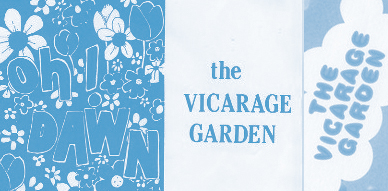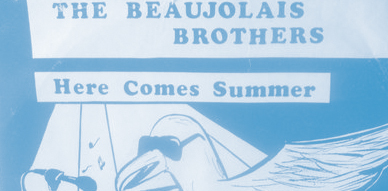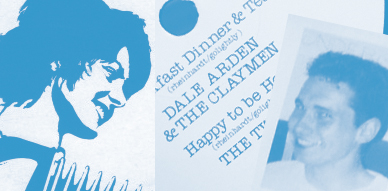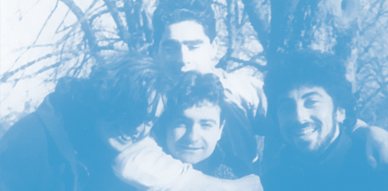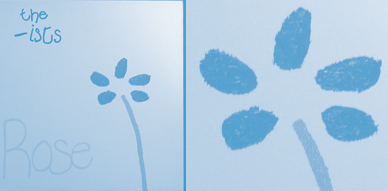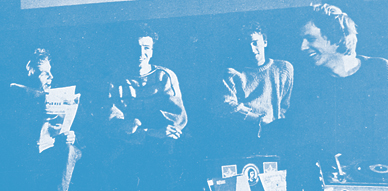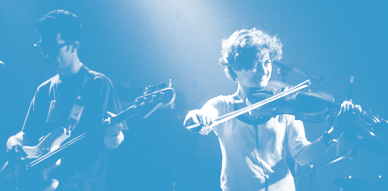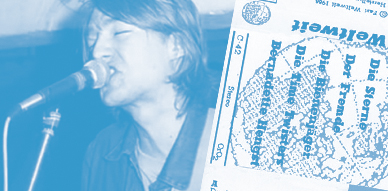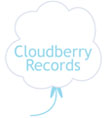May
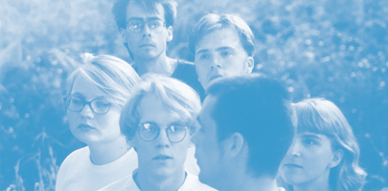
Thanks so much to Johan Gille for the interview! Got in touch with Johan thanks to the Watermelon interview. Thanks to that, he noticed I had written about his old band Théhuset on the blog. I was very happy to be able to ask all of these questions as that one release they put out was quite a mystery to me. Even better, to discover there are more songs by the band, and finally seeing photos of the band, has been quite a treat! Also so you know Johan has been in another classic band, Able, who are still going and who we’ll be doing an interview very soon too! Check them out! Hope you all enjoy reading the story of this obscure but fantastic Uppsala, Sweden, band!
++ Hi Johan! Thanks so much for getting in touch! How are you? Where are you at now? Still in Uppsala?
Hi Roque, and thanks to you! I’m in Uppsala, doing my duties at the university, bringing up kids, playing music, generally living.
++ You got in touch thanks to the connection with Erik from Watermelon Men, how lucky for me. But how did you two know each other? Did you ever make music together?
I moved to Uppsala to study, and I started studying Spanish. Erik was in the same course, and we became friends. He was a bit older and had been playing quite a while with Watermelon Men by then. He opened my eyes to a lot of things, and I’m very grateful for it. We played a few gigs as an acoustic duo, mostly covers as I remember it (singer/songwriter stuff, The Church, sixties pop…). I bumped into Erik the other day, it’s great that he’s making music again (with Distant Days).
++ Are you all from Théhuset still in touch to this day? What are you all up to?
Not that much, to be honest. It’s been a long time, and we all live in different parts of the country by now, but we get in touch every now and then.
++ You are still making music with Able right now right? Would be great to do an interview later about Able, but at this moment, what is coming up for the band?
Yeah, we are actually, and it feels great. Over the winter we’ve been recording songs for a new album, and we’ll continue with that until we’re satisfied with it. After that, we’ll see what happens. We played a show just the other week, and it felt fantastic. We’d love to play in New York. 🙂
++ Let’s start from the beginning. Like what are your first musical memories? What was the first instrument did you get and how?
Oh, wow. I remember having a plastic toy guitar by the age of three. My parents played a lot, especially my father, who had been in bands since the 60’s, and was out playing every other weekend. So music was a natural part of life growing up. His father (my grandfather) had played in bands since the 30’s, and his parents in turn met when playing in some religious context back in the late 19th century. I started taking guitar lessons by the age of 8, and kept playing though I gradually moved away from playing music on sheets. I wanted to get closer to the magic of songs. I was intrigued by that. How do you write a song? A bit later, when I was 13 or so, I started studying Paul Simon’s songs, and then I wrote my first songs. Which were pretty horrible.
++ Had any of you been involved with other bands prior to Théhuset?
Some of us did actually play in a band in Borlänge (where I grew up, two hours north of Uppsala) before Théhuset. It was called Projekt Byrån, but we didn’t have a clear sense of direction, to put it diplomatically. When some of us started to figure out what kind of music we wanted to make, there was a flurry of activity for a while. There was one band called Barking Up The Wrong Pyramid, which eventually led to Théhuset being formed.
++ How was Uppsala back then? Were there any bands that you liked? What were the good record stores? Or what about the pubs or venues to go check out up and coming bands?
Théhuset was actually formed in Borlänge, we relocated a bit later. Borlänge was a pretty good place to be in a band back then. Not that there were many (or any!) bands around that we felt similar to, but there were a few places to play, and a good crowd at most of them. The music scene there was generally more oriented towards heavier stuff. A lot of heavy metal. At the time, Sator (Codex) were making their first records, Blue For Two were also getting a lot of attention. We played softer pop songs, and in Swedish, with a flute. It’s no overstatement to say that we didn’t quite fit in. In that sense, it felt like a relief when we moved the band to Uppsala, which was far more open-minded musically. Being able to play at the student clubs (“nations”) was also a great way to get practice. That said, Borlänge had (and has) one of the best record shops in the country: Folk å rock, run by the great Ingemar Magnusson. I only realized after I left how special that was.
++ When and how did the band start? What was the recruiting process like?
The band formed around 1987-1988 in Borlänge, when Jonas Leksell, Gunnar Alm and I started having an idea on what we were supposed to be doing musically. I’m not entirely sure who joined when, but you could say that there were two versions of the band. The first line-up was Jonas on drums, Gunnar on bass and me on guitar and vocals. Soon after that, Anna Blomqvist joined on flute (which was a pretty radical instrument to have in a band in Borlänge at the time) and tambourine. In this first version, we were all close friends before forming the band. Jonas and I had been to school together, Gunnar was living with my sister, and I was going out with Anna. The second version of the band was when we were in Uppsala. Lotta Nyblad joined on guitar and vocals, Patric Thuresson on violin and guitar, and then Tomas Bergman replaced Gunnar on bass. After a while, Anna had to leave, and Anna Carlsson came onboard.
++ Why the name Théhuset?
I think we wanted a name that went along with the soft and slightly intellectual character of the music (as compared to the other bands around in Borlänge). We were also heavy tea drinkers, and some of us had been reading “The Teahouse of the August Moon”.
++ How was the creative process for you? Where did you usually practice?
I would write the songs, or sketches of songs, and have pretty specific ideas about the arrangements, which would be adapted by the band as they saw fit. At first we practiced in Jonas’ basement in Borlänge, but in Uppsala we eventually had a place around the corner from my flat where we rehearsed when we were the six of us. Lotta and I would play a lot at home too. Towards the end, it got more difficult. Tomas lived two hours away, Jonas in Stockholm. So we didn’t exactly rehearse twice a week by then.
++ And who would you say were influences in the sound of the band?
Many! The Go-Betweens, the Church, Big Star, the Byrds, Prefab Sprout, the Sugarcubes, Elvis Costello, Suzanne Vega, the Triffids, Sarah Records in general, the Cure… The list could go on and on. Any music with a heart and brains.
++ What would you say are your all-time favourite Swedish guitar pop bands? And why do you think there’s been always quality Swedish pop bands up to this day?
At the time we started Théhuset, there really wasn’t a whole lot. We’d listened to some Swedish new wave bands, like Reeperbahn, Camouflage and Tant Strul, but as far as we were concerned, the 80’s wasn’t a great period for Swedish guitar pop. But that might have been us living in our bubble. We hadn’t even heard Watermelon Men, for instance. Anyway, things changed in the 90’s, a lot! The first sign of things changing was, for me and I remember discussing this with Erik Illes at the time, “My Hometown” by the Wannadies in 1990. It’s hard to pick one band among so many great ones. You’d have to mention Eggstone, obviously, they were brilliant, but there were so many, from Bear Quartet to Stevepops to Cloudberry Jam by way of countless great people and bands. I honestly have no idea why there has been so many good Swedish pop bands. One reason people usually mention is the general music training that we’d get back then, which meant that when you formed a band, the people would have a basic schooling and generally know how to play. That helps, obviously, but I’m not sure if it explains it, really.
++ Your one record was released by Ambush Records. Who were they? And how did you end up in the label?
It was through Mattias Bolkeus Blom, a friend of mine who knew the people running the label. It was all pretty simple with them, hardly any discussions at all. But I don’t know much about that label.
++ There are three songs on the record, “Egen Värld”, “Världens Bästa Dag” and “Tänk På Något Annat”. If you don’t mind, in a sentence or two, tell me the story behind these songs?
“Egen värld” was to our own ears perhaps one of the few proper pop songs we had then. Many of the other ones were all a bit… quirky. Which isn’t necessarily a bad thing. Ask Paddy McAloon. The lyrics are about a loved one you can’t communicate with anymore due to illness. And the flute solo was inspired by Bach! For some reason, this was the only song that for a long time had English lyrics, I had to write new ones for the recording. “Världens bästa dag” used to go over quite well when we played it at gigs. Might have been one of the few songs where we had a harmonica. The lyrics tell a rather twisted tale of a couple cheating on each other. Don’t know where I got the inspiration for that! “Tänk på något annat”: I distinctly remember sitting on the floor in the rehearsal room writing the lyrics to this one after reading far too many Borges and Cortázar novels for anyone’s mental health. The narrator is in anguish about not actually being him, but rather a dream made up by someone else, while the girls try to calm him down, telling him to think of something else (which quite easily could be taken as evidence that he was actually right all along). I can see now that we didn’t really write songs about the normal stuff…
++ How was the experience recording them at MBS Studios?
It was our first time in a proper recording studio, and the engineer had some strange ideas. He didn’t want to use compressors, for instance, which everyone uses, and for obvious reasons. We had a really hard time getting radio to play the single. They liked it, but the volume on the record was a whole lot lower than on other recordings, so it was hard for them to fit it into the playlists. I don’t think the engineer was very used to recording pop music, to be honest. It wasn’t the best experience, but we learned a lot. And I like the fact that we played the backing tracks live, all of us at once.
++ Tell me about the art of the record, who is the girl from the photo?
There was this postcard that we had, I don’t know where it came from, but we used to have it on our posters. She became the Théhuset girl. So it made perfect sense to put her on the cover.
++ Are there any other releases by the band? What about compilation appearances?
There were no other official releases, but we recorded a couple of demos, and there’s a live recording as well. One of the demos was named “Demo of the month”, or something like that, in a Swedish music magazine.
++ What about unreleased songs? Are there any still?
Well, there are those demos, about 11 songs altogether, and the live recording, but we didn’t record any other songs in a studio.
++ Was there any interest from other labels perhaps?
I don’t know how hard we tried to promote ourselves, but knowing ourselves I’d say probably not very much. There was some interest from labels, but I don’t know how serious it was. And not long after the single, the band was dissolved, leading eventually to Able forming in -93.
++ What about gigs? Did you play many? Any in particular that you remember?
We played quite a lot, around Uppsala mostly, at student clubs primarily, but also quite a lot in our native town of Borlänge. The most memorable gig was probably playing to a big crowd at Dalarna University in Borlänge. That was a great gig. At one point, my father joined us on stage to play the accordion. And my mother was furious with me afterwards because we had played too loud. I tried telling her that we weren’t the ones to blame, but she’d have none of it.
++ And were there any bad gigs at all? Any anecdotes you could share?
I’m sure quite a few of them were sub-standard, especially in the beginning, when we were all pretty new to having gigs and dealing with everything around it. At our very first show in Uppsala, the engineer got the idea that the flute and my guitar competed in the same frequency range, whereby he promptly brought my guitar way down in the mix, leaving the band basically sounding like drums, bass and flute. I tried to compensate for that by playing harder on my guitar, which inevitably lead to me breaking a string on the first song… So that show was a bit of a disaster, especially since there were some record company people there checking us out. But apart from that we had a great time together, and in time we grew to be a pretty efficient live machine. As far as anecdotes go, every time we played in Borlänge it would take about one song or two before people started shouting on us to do songs by Creedence Clearwater Revival. We never did.
++ When and why did you split? Did you all continue making music afterwards?
It was towards the end of ’92 and mostly due to practical reasons. People living in different parts of the country. All of us kept playing afterwards. Jonas played with the Standards (they were pretty successful), Patric formed a ska band (Rude boys). Lotta and me started Able.
++ Was there ever a reunion gig or talks of a reunion gig?
Not that I remember. We’ve been living in different parts of the country, playing in new bands, eventually raising kids and having less and less time for it. But who knows what happens?
++ Did you get much attention from the radio or press?
We were an underground band all along, but we received some attention. We did some interviews for radio and newspapers, the demo was picked and featured in a magazine. The 7″ didn’t sound like it should have to be played in the radio at the time, though.
++ What about from fanzines?
I don’t know if there were many Swedish fanzines around at the time that wrote about that kind of music. If there were, they didn’t find us. Ha ha.
++ And today, aside from music, what other hobbies do you have?
Well, there isn’t a lot of time for hobbies when you have children and a full-time job, so we’re happy to find time for the music. Other than that, I am a linguist by profession and that’s kind of a hobby as well. And I’m a pretty good golfer.
++ Looking back in retrospective, what would you say was the biggest highlight for the band?
It’s hard to pick one single thing. What I keep and value most from that time is how good friends we were, and all the good times we had together. I also remember recording one of the demos, with a hi-fi wiz in a concert hall in Uppsala. We recorded the whole thing live, no overdubs. The memories from that session are all envolved in pink fluffy clouds.
++ How is Uppsala today? I visited once and really liked it. But compared to the Théhuset days, has it changed much? If a reader of this interview was to visit one day, what would you say are the sights I shouldn’t miss? Or the traditional food or drinks I should try?
I love Uppsala, I have since the day I came here. It has a bit of everything without being a big city, and the university has its stamp on much of it (which is a good thing and a bad thing, but coming from Borlänge it has mostly been a good thing for me). The city’s grown since then, and now has a football team in the top division (IK Sirius, which we support wholeheartedly). The music scene is quite different, though. There aren’t many venues that offer live music, which is a real shame. Considering the size of Uppsala, and the music being made here, there should be a lot more. A tourist to the town should probably spend some time just walking around, stopping by the normal sights (the cathedral, the castle, the university, Gustavianum, the botanical gardens…), all of which are within easy walking distance. I think many would want to make the trip out to Gamla (‘Old’) Uppsala, to get a feel of the Viking age.
++ Thanks again Johan! Is there anything else you’d like to add?
Thanks to you, Roque! I’m quite impressed that you found Théhuset. Keep up the good work!
::::::::::::::::::::::::::::::::::::::::::::::::::::::::::::::::::::::::::::::::::::::::::::::

